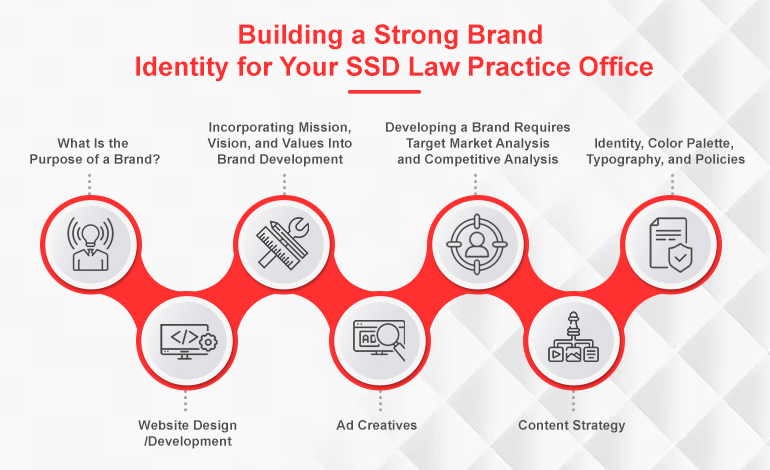
Aside from dealing with the physical, emotional, and financial toll of their disabilities, applicants for Social Security Disability (SSD) benefits also face a convoluted legal system. Applying for SSD benefits involves navigating a bureaucratic maze that involves obtaining detailed medical, financial, and employment records, all the while facing a high likelihood of initial application rejection. These obstacles frequently leave applicants feeling overwhelmed, isolated, and even more financially stressed.
In this article, we’ll explore how your SSD law firm or advocacy group can help simplify the application process for your potential clients; SSDI and SSD benefits applicants. An effective content marketing strategy, involving content production and blogging, for this audience needs to provide clarity and guidance through the labyrinth of the US Social Security Administration’s office and programs. By covering important subjects like the kinds of information, requirements, documentation, applicable laws, and proof of success your content and blog can become a useful resource for those who need help.
Understanding Your Audience

Naturally, the first step is to truly know and understand who your audience is, their characteristics, and behaviors to effectively communicate with them. The typical SSD applicant is someone who is over the age of 45 and cannot work due to a physical or mental disability. Within this group are often people who have been through life-changing accidents that left them with long-term or permanent impairments. These circumstances impact their daily lives, challenging their ability to earn an income and meet their financial necessities.
Your audience isn’t just defined by their legal needs; they’re individuals dealing with significant life challenges. Your content should reflect an understanding and sensitivity to these hardships.
Writing Client-Focused Content
When writing about Social Security Disability, focus on the real-life concerns of applicants. Picture Sara, who’s struggling with a chronic condition and unsure if she would even qualify for SSD benefits. Your content resources and/or blog can double as a guide, simplifying the process, from qualification criteria through benefits disbursement and answering common questions. Here are some examples of different types of content your firm or representation company should produce:
- Step-by-Step Guides: Break down how to apply for SSD benefits, into simple, easy-to-follow steps.
- Success Stories: Share narratives like John’s, who successfully appealed a denied application, to illustrate the process and inspire confidence.
- Practical Tips: Offer advice on gathering medical evidence and managing finances during the application period. Use examples to make the information relatable and actionable.
- Disability-Specific Content: Since SSD covers a range of disabilities, create content tailored to specific conditions. This shows a deep understanding of diverse client needs.
- Community Resources and Support: Provide information on community resources, support groups, and other external aids available for people with disabilities.
- Legal Updates and Changes: Keep your audience informed about any changes in SSD law, policy updates, and what these mean for applicants.
Essentials of Effective Blogging for SSD Law Firms

Blog writing is a less formal and more conversational way to connect with potential clients and provide them with information about your SSD law practice. Here’s how to turn your blog into an effective tool:
Balancing Legal Jargon with Reader-Friendly Language
Simple language, like “steps to appeal a decision,” can help make legal topics easier to understand on your blog. Avoid using technical terms like “appellate process.” By doing so, the content becomes more approachable and interesting, which in turn makes readers feel informed and motivated. Every blog post should be easy to understand, helpful, and use real-life examples to explain complicated legal processes.
Use Engaging Headlines and Subheadings
Write headlines and subheadings that are informative and attention-grabbing. They should give a clear idea of the content and entice the reader to explore further. For example, “5 Common Mistakes in SSD Applications and How to Avoid Them” is both informative and engaging.
Incorporate Visuals and Infographics
Break up text-heavy content with relevant images, charts, and infographics. Visuals can help illustrate legal concepts or statistics, making them more understandable and engaging for the reader.
Encourage Reader Interaction
End your posts with a call-to-action, like encouraging readers to comment with their questions or share their experiences. This not only boosts engagement but also provides valuable insights into what your audience is looking for.
Regularly Update and Repurpose Content
Keep your blog fresh by updating older posts with new information, and consider repurposing content into different formats, like turning a blog post into a short video or a podcast episode. This helps in reaching a wider audience and catering to different content consumption preferences.
Content Ideas and Topics for SSD Law

- Discussing Recent Changes and Updates in SSD Law:
- This type of content keeps your audience informed about the latest developments in SSD law. For example, you can write about new legislation, policy updates, or changes in the application process.
- Offer insights into how these changes might impact current and future SSD claimants.
- Consider doing a monthly or quarterly round-up of changes in SSD law to keep your readers up-to-date.
- Case Studies and Success Stories:
- Share real-life success stories and case studies of clients who have successfully navigated the SSD system.
- Highlight the challenges faced, the strategies used to overcome them, and the outcomes achieved.
- These stories provide practical insights and offer hope to others in similar situations.
- Common Challenges and Solutions in SSD Claims:
- Identify and address the common challenges faced by individuals applying for SSD benefits. These might include understanding eligibility criteria, compiling the necessary documentation, or handling claim denials.
- Provide practical advice and solutions to these challenges. For instance, offer tips on how to gather and organize medical records or how to prepare for an appeal hearing.
- Include expert advice or insights from experienced SSD lawyers to add credibility and depth to your content.
Strategies for Enhancing Online Visibility

The higher your content and blog’s online visibility, the more readers can find and engage with your posts. To stand out, try these strategies:
SEO for SSD Firms
Aside from writing authentic and helpful content for the disabled community in need of government assistance, you also have to optimize your content and blog for search engines. This ensures that when someone searches for information related to SSD law, your content appears in the search results. Key SEO strategies include using relevant keywords (like “SSD benefits application process” or “disability law advice”), creating quality content regularly, and ensuring your website is user-friendly and accessible.
Implement SEO Best Practices
- Advanced Keyword Research: Go beyond basic keywords. Use long-tail keywords that potential clients might use in specific situations, like “applying for SSD after sudden disability” or “SSD eligibility for chronic illness.”
- Local SEO Optimization: Since SSD law often serves local communities, optimize your website for local searches. This includes listing your firm on Google My Business and incorporating geo-specific keywords.
- Technical SEO: Ensure your website is technically sound with fast loading speeds, mobile optimization, and secure connections (HTTPS). A technically efficient site is favored by search engines.
Using Social Media to Amplify Content
- Targeted Social Media Campaigns: Use platforms where your potential clients are likely to engage. Share content on these platforms with excerpts or infographics that encourage clicks.
- Engagement Strategies: Respond to comments, engage in SSD-related discussions, and use social listening tools to understand what your audience is talking about and how to tap into these conversations.
Link Building through Guest Posting and Collaborations
- Strategic Partnerships: Collaborate with healthcare blogs, disability advocacy groups, or legal forums. Guest posts or featured articles on these platforms can direct a relevant audience back to your content or blog.
- Resource Sharing: Develop comprehensive resources that other websites would want to link to, such as detailed guides or infographics on SSD laws and changes.
Engaging Your Readership
- Encouraging Interaction and Feedback: Create interactive blog posts, like quizzes or surveys about SSD topics, and encourage comments by asking direct questions to your readers.
- Effective Call-to-Action Elements: Use CTAs that offer real value, like free consultations or downloadable resources in exchange for email subscriptions.
- Consistent Online Presence: Regularly update your blog and social media channels. Consistency keeps your audience engaged and helps establish your firm as a reliable source of information.
Planning and Consistency

Be consistent and plan ahead if you want your content strategy to succeed. Here’s how to make this happen:
Develop a Content Calendar
A content calendar helps you map out topics, align content with key dates or legal updates, and ensure a balanced variety of content. This allows you to stay ahead and avoid last-minute rushes, ensuring a steady flow of quality content.
Maintain a Consistent Schedule
Determine a realistic schedule, whether it’s weekly or bi-weekly, and stick to it. This regularity helps build audience anticipation and trust. You can use automation tools for scheduling posts to maintain consistency, even during busy periods.
Prioritize Quality vs. Quantity
In legal content writing and blogging, quality outweighs quantity. It’s better to post well-researched, informative articles less frequently than to post mediocre content frequently. Focus on creating posts that add real value by addressing legal issues in an accessible way.
Measuring Success and Adapting Strategies

Tools and Metrics for Tracking Performance
Use tools like Google Analytics to track your blog’s performance. Key metrics include page views, session duration, bounce rate, and source of traffic. Regular analysis of these metrics gives you insights into what content resonates with your audience and what doesn’t.
Adapting Strategies Based on Analytics and Feedback
Be agile in your strategy. If certain topics or formats get more engagement, consider producing more content in those areas. Regularly seek feedback from your readers and be open to adapting your content strategy based on their preferences and needs.
Staying Updated with Legal and Digital Marketing Trends
The SSD legal field and digital marketing landscape are ever-evolving. Stay informed about legal developments, SEO trends, and content marketing strategies. Attending webinars, subscribing to industry newsletters, and participating in legal marketing forums can keep you at the forefront of effective content practices.
Content Marketing to Establish Firm Credibility

Producing content is more than just writing an article or blog post; you need to know your audience inside and out and make sure your pages and resources are search engine optimized. Of equal importance, you need to publish regularly and track metrics to make an online presence.
Moreover, content marketing is an effective means for debunking negative assumptions about lawyers, like the idea that they only practice for profit and charge exorbitant fees. Instead, it allows firms to show their genuine desire to help SSD applicants.
Finally, blogging is a very useful tool for marketing. By providing readers with less formal educational content that establishes the firm as a reliable resource, it can draw in new clients and foster referrals.
Need some help getting started with your content strategy? At DL Marketing, we create strategies and can assist SSD law firms in creating a compelling narrative and content that speaks to their prospective clients. Get in touch with one of our strategists today!


